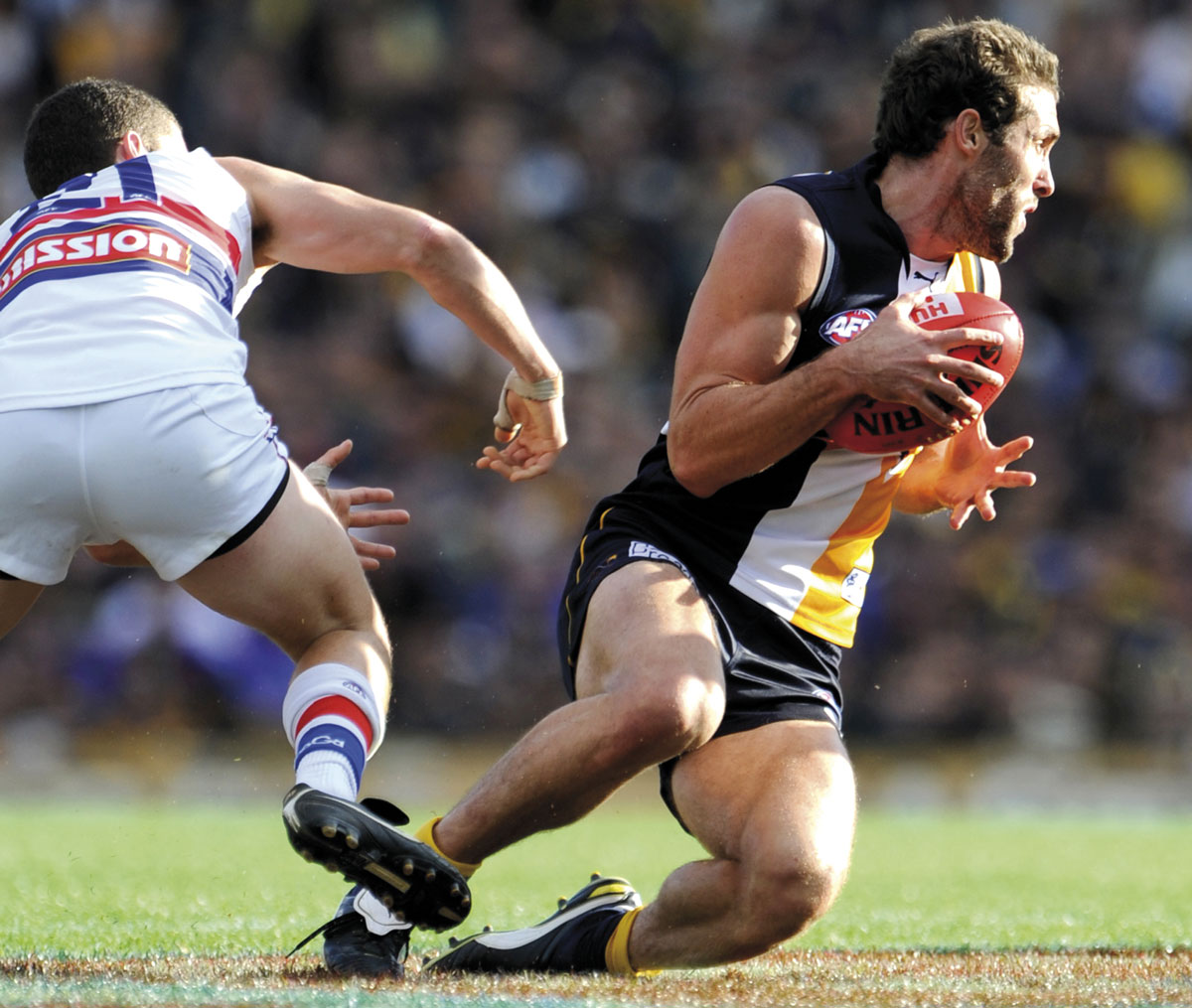 ED: Unfortunately, injuries amongst Australian Rules Footballers are relatively common and many are preventable.
ED: Unfortunately, injuries amongst Australian Rules Footballers are relatively common and many are preventable.
Australian rules football is played by well over half a million people of all ages, from weekend warriors to the elite semi-professionals. The injury rate is higher than many other team sports, mostly involving the hamstring, groin/hip, thigh, knee, ankle and shoulder. Injuries occur more often in the first few weeks of the season, suggesting a lack of fitness and conditioning. Overuse injuries, such as stress fractures and tendinopathies, are more common in those training more and at a higher level, and in older footballers.
The impact of football injuries is significant: time off work, lack of exercise, cost, and impacts on mental health. Most of us know someone who quit sport and no longer exercise due to injury, contributing to the sedentary lifestyle that has become Australia’s leading cause of morbidity and mortality. For example, an ACL rupture in young people can lead to short-term reduced sporting ability and participation, impaired self-confidence, and even impaired learning. Long term, ACL rupture is a major cause of knee osteoarthritis, which adversely impacts on quality of life and finances.
Responsibility for injury prevention (IP) lies with several stakeholders. The game’s administrators and officials are responsible for providing an environment and setting rules facilitating safe play. Professional AFL players are closely managed and IP exercises are prescribed by a specialised multidisciplinary team. Everyone else is left to their own devices, poorly managing their injuries and jogging a few laps as a warm-up. While many AFL footballers consider IP, most do no more than purchase a mouth guard.

Putting prevention into action
Whilst primary prevention is the holy grail, most players do not present for screening or advice beforehand. In winter, my Mondays are littered with the fallout from weekend sport – I doubt if any GP goes a week without seeing a football-related injury. This is an opportunity to not only treat the presenting injury but also advise on secondary prevention. A simple ankle sprain may seem relatively insignificant but an IP program can reduce the future risk of an ACL rupture, Achilles’ tendinopathy or osteitis pubis.
Proper sport-specific conditioning is very important. The focus is on reducing neuromuscular and biomechanical risk factors by improving strength, power, flexibility, endurance, agility and proprioception. IP exercise programs are incorporated into a preseason training as well as maintenance throughout the season.
The inaugural AFL Women’s season saw a high incidence of injury early on, probably in part due to a short preseason and many athletes coming from other sports. They simply did not have enough time to develop the specific physical conditioning required in elite football.
Numerous exercise programs are online for IP, however a good Physiotherapist or Accredited Exercise Physiologist is useful for more thorough individual programs. Many beneficial IP exercises, such as plyometrics, can result in injury if performed incorrectly, too frequently, or too early in a program, so encourage professional guidance. To improve compliance, emphasise the positive effect on performance and on-field success!
Large-scale IP programs worldwide include the FIFA-11+ for soccer. In 2015, the AFL unveiled a major initiative aimed at reducing injury. It was largely funded by the NHMRC, AFL, and state governments. FootyFirst is a simple, easy to follow, progressive exercise training program specifically developed to reduce the risk of common lower limb injuries. It is easily transferable, can be applied to individuals or entire teams, and can be incorporated into a more traditional warm-up. This is an invaluable resource, and I highly recommend it for any footballer, injured or not.
Key messages
- Football injuries burden patients and society, and many are highly preventable
- Sport-specific conditioning and gradual increases in exercise load are vital
- Direct patients to FootyFirst at aflcommunityclub.com.au
- According to the 2015 AFL Injury Survey, since 1992, the incidence of new injuries has been about the same, as has the games lost to injuries but recurrent injuries have about halved. At this elite level, hamstring and groin strains top the list, with knee injuries of various sorts largely unchanged, but calf and ankle strains or sprains more prevalent in line with the ‘running game’ spectators enjoy. The author says, “The groin injuries have seen a downward trend in recent years due to improved screening and IP programs. There is evidence of an increase in ACL injuries with a higher friction between ground and foot. Footwear design and stud pattern can contribute to this but there is a definite link with the type of turf. Incidence increases as you go further north in Australia and earlier in the season, due to hotter and drier conditions increasing the traction. Turf type has an influence too, with higher thatch grass varieties such as bermuda worse than rye grass. The new Perth Stadium has a mix of wintergreen couch, with rye added in winter, and stabilised by 10% artificial turf fibres.”
References available on request.
Questions? Contact the editor.
Author competing interests: nil relevant disclosures.
Disclaimer: Please note, this website is not a substitute for independent professional advice. Nothing contained in this website is intended to be used as medical advice and it is not intended to be used to diagnose, treat, cure or prevent any disease, nor should it be used for therapeutic purposes or as a substitute for your own health professional’s advice. Opinions expressed at this website do not necessarily reflect those of Medical Forum magazine. Medical Forum makes no warranties about any of the content of this website, nor any representations or undertakings about any content of any other website referred to, or accessible, through this website.

